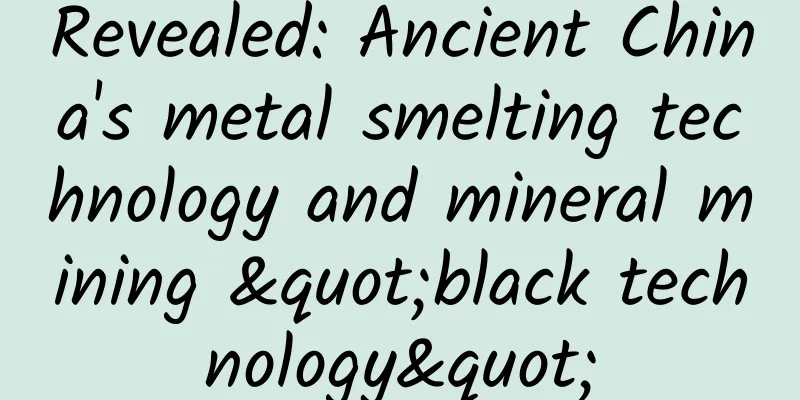Revealed: Ancient China's metal smelting technology and mineral mining "black technology"

|
In the history of human civilization, metal smelting and the production and use of metal tools are important turning points for mankind to move from ignorance to civilization, with a history of only about 6,000 years. As an advanced agricultural region, ancient China did not start early in the use of metal tools, but it had unique advantages and was once ahead of the world. The emergence of metal smelting and metal tools marks the beginning of human civilization! Historians often classify the stages of human civilization based on the materials used in tools, including the Stone Age, the Bronze Age, and the Iron Age. In fact, before entering the Metal Age, about 40,000 years ago, humans recognized natural metal elements, especially gold and copper with good chemical stability , but the quantity was very small and could not be used to make tools, so they could only be used as decorations. The first metals produced by human beings' " thermal metallurgy " should be lead and silver, which are metals that seep out during the high-temperature firing of pottery. Because there is a lot of lead-containing clay in nature, it is particularly easy to obtain lead. After that, humans continued to accumulate experience in high-temperature refining of metals, and smelted copper and copper alloys on a large scale and used them to make tools. But gold is different . Until modern times, it was mainly obtained by "gold panning" and rarely mined and smelted. Archaeological evidence shows that about 6,000 years ago, the Mesopotamian civilization in the Mesopotamian Valley of West Asia first smelted bronze on a large scale. Bronze is an alloy of red copper (pure copper), tin and lead. Bronze has good strength and rigidity and can be used to make tools, marking the beginning of the "Bronze Age" of human civilization (until the beginning of the Christian era, about 4,000 years ago). Such a huge progress has even been attributed to aliens ! 1. The metal civilization in China appeared slightly later, but it had a unique and technologically advanced "Bronze Age". At the Erlitou Site in Yanshi, Henan Province, about 3,700 years ago, a large number of China's earliest bronze wares, bronze ornaments, and "copper casting workshops" were unearthed! This indicates that China had indeed entered the Bronze Age at that time, slightly later than Western countries. However, many archaeological evidences show that from the Shang and Zhou Dynasties to the Western Han Dynasty, China had a technologically advanced and highly prosperous smelting copper industry, which once led the world ! Generally speaking, bronze in Western countries is mainly used to cast tools and weapons, while bronze vessels in China during the Shang and Zhou dynasties had a wide range of shapes and uses, including cooking utensils such as ding and gui (guǐ), wine vessels such as jue and gu (gu), weapons such as ge, spear, axe, arrowhead, tools such as shovel and knife, musical instruments such as cymbals (percussion instruments), etc., and the metal alloy ratio is reasonable. The ancient book "Zhou Li·Kaogongji" mentioned the copper and tin content ratio of various bronze vessels. Archaeological evidence shows that the Shang Dynasty had very advanced bronze smelting and casting technology. The entire Shang Dynasty was constantly improving the "composite clay mold" casting technology. The clay mold had a complex structure and a large volume. From the initial casting of small jue and xiao, to the late Shang Dynasty, the world's heaviest known bronze ware "Houmuwu Ding" was cast, weighing more than 830 kilograms. As for bronze ware with complex and exquisite shapes and patterns (such as the Four-Ram Square Zun), they are everywhere. The bronze casting technology of the Zhou Dynasty reached an extremely high level, as evidenced by the fact that bronze ware had inscriptions of several hundred characters, with clear and regular handwriting. In addition, the quality of clay molds at that time was improved and could be reused several times. The "stack casting method" (assembling multiple clay molds together) also appeared, which could cast multiple castings at a time, so that small bronze castings could be mass-produced. In terms of raw material security, from the Shang and Zhou Dynasties to the Western Han Dynasty, the Chinese generally mined copper by digging shallow wells and "hole extraction" . Ancient copper mine sites from the Spring and Autumn Period have been discovered in Linxi, Inner Mongolia and Daye, Hubei. The Daye ancient mine, in particular, had the most advanced mining and smelting technology in the world at that time. It is estimated that more than 100,000 tons of copper were smelted here. Common knowledge : The copper reserves in China, especially in the Central Plains, are not rich, which caused some troubles in the production of bronze wares and later copper currency (copper coins). Therefore, the ancient Chinese attached great importance to exploration and mining. At that time, it was extremely difficult to find ore, and it mainly relied on "eyesight" and experience observation. A large number of craftsmen had been looking for ore in the wilderness for many years! "Guan Zi" recorded the experience of finding ore based on "ore seedlings" (the part of the mineral that naturally exposed on the surface); during the reign of Emperor Wu of the Han Dynasty, in order to cast copper coins, 100,000 people were driven every year to " attack the mountains to get copper and iron ." 2. Due to the common technological traditions of copper smelting and iron smelting, China once formed a technologically advanced "Iron Age". Humans first recognized the hard substance "iron" in meteorites and used it to make blades and ornaments. However, natural metal iron is very rare and must be obtained through refining. It was during the thousands of years of the long Bronze Age that humans gradually mastered the iron smelting technology with a higher melting point through the application of bronze smelting technology and ushered in the Iron Age! Archaeological evidence shows that the "copper-handled iron-blade dagger" unearthed from the tombs of the Hittites in Asia Minor (now Turkey) about 4,500 years ago is the earliest smelted iron in the world. About 1,000 years later, this place entered the Iron Age and was gradually spread to the Middle East and Europe. In China, two iron bars dating back more than 3,300 years were unearthed in a Shang Dynasty tomb in Lintan, Gansu Province. A little later, there was also an "iron-bladed copper axe" from the Shang Dynasty. The jade-handled iron sword from the Guo State in the late Western Zhou Dynasty, about 2,800 years ago, was already an all-iron weapon. In the early Warring States period in 500 BC, China officially entered the Iron Age, slightly later than Western countries. In the following hundreds of years (until the Western Han Dynasty), bronze was not completely eliminated , and bronze and iron were mixed. Direct evidence is that tens of thousands of bronze weapons were unearthed in the Mausoleum of Qin Shihuang, and very few iron weapons were unearthed. Why did the Qin people not want to use light, sharp, and strong iron weapons? Perhaps it was because the copper smelting industry at that time was very advanced and developed, and there was no need to eliminate it all! It is also possible that the scientific and reasonable copper alloy ratio offset the disadvantages of bronze to a certain extent. But it is also because of the advanced bronze smelting technology and the long-term mixing of copper and iron that the ancient Chinese developed the world-leading "blast furnace iron smelting" (appeared in the late Warring States period) technology from the "vertical furnace copper smelting" technology of the Spring and Autumn Period, and produced cast iron (pig iron) and subsequent advanced steelmaking technology. For a long period after the Western countries entered the Iron Age (until the Middle Ages in Europe), they continued to use copper smelting technology at a smelting temperature of about 900 degrees Celsius, which resulted in sponge-like iron blocks with more impurities, low carbon content, and relatively soft, requiring repeated forging to produce simple ironware. In contrast, the temperature of ancient Chinese blast furnaces could reach over 1150 degrees Celsius, which could form cast iron and cast into utensils, with a high carbon content, few impurities, and a hard and brittle texture. After the Han Dynasty, China's iron smelting technology still led the world. In general, the furnace type of China's iron smelting blast furnace was scientific and reasonable, very tall, and improved the smelting effect and efficiency; the leather wind bag with manual pressure was used for blowing in the Warring States Period, animal-powered blowing appeared in the Western Han Dynasty, and hydraulic blowing appeared in the Eastern Han Dynasty. From the Song Dynasty to the Ming Dynasty, the "piston-type wooden bellows" were improved; coal was widely used as iron smelting fuel in the Northern Song Dynasty, and coke was used in the Southern Song Dynasty. In terms of steelmaking, the "hundred-fold steelmaking" technology appeared in the Warring States Period , which is to repeatedly heat and forge pig iron with a high carbon content dozens or hundreds of times to form tough, sharp and durable steel bars. This technology was very mature in the Eastern Han Dynasty, hundreds of years earlier than Europe. In order to simplify the forging process, the Chinese also created a unique "stir-fried steel" process in the Western Han Dynasty, and continued to improve it. It is to add ore powder to the pig iron water, and then stir it continuously. Through the mixing of the molten iron with air, burning and oxidation, the carbon content in it reaches a proportion close to that of steel. 3. The promotion of China’s agricultural production by metal farm tools. The Zuo Zhuan says: " The most important affairs of a country are sacrifice and war. " Therefore, the rare and precious metal raw materials in ancient China were mainly used to make ritual vessels and weapons. However, as one of the oldest and most advanced farming areas in the world, the people of China naturally attach great importance to agriculture and have used metal to make farm tools and improve agricultural production efficiency for a long time. In the Stone Age, ancient Chinese mainly used stone farm tools, including stone hoes (sì, like a shovel) and stone plows (lěi, like a fork) for loosening the soil, stone axes and knives for felling trees, and sickles made of clam shells and animal bones. In the Spring and Autumn Period, farm tools were still mainly made of stone, wood, bone, and sticks, but the smelting and copper making industry was very advanced at that time, so bronze farm tools became more common, such as hoes, shovels, sickles, etc., which are not much different from modern ones in appearance. Bronze farm tools in the Spring and Autumn Period and the Warring States Period were not popular and not very easy to use. It was not until the late Warring States Period that iron farm tools completely replaced stone farm tools. Tips: It was definitely a feat for humans to domesticate the "strong and powerful" wild cattle and use animal power! After cattle were domesticated, they were soon used in agricultural production, and cattle plowing was a major agricultural progress! There were records of "iron plows and cattle plowing" in China during the Spring and Autumn Period, and a series of supporting agricultural tools such as "plows" appeared accordingly. However, the plows at that time were not made of iron, but wooden plows and stone plows. In the Han Dynasty, ox-drawn plows and iron farm tools were widely used, marking a "leap" in the level of agricultural productivity in ancient China . After the Han Dynasty, China's iron production continued to expand, iron-mouthed farm tools gradually became all-iron farm tools, and the styles of iron farm tools continued to improve and the variety gradually increased, including the plows required for ox-drawn plows, which became more and more sophisticated and practical. I will not go into details. In short, the great achievements of ancient China's metal smelting technology, as well as the development and evolution history of agricultural tools, fully reflect the diligence and wisdom of the ancient Chinese! |
>>: Correctly understanding sleep and snoring can help us sleep better!
Recommend
Taizhou Mini Program Customization Company, how much does it cost to customize an e-book mini program?
There are two types of customization of Taizhou e...
Are sun protection clothes worth tens of dollars a rip-off or are they really useful? This article teaches you how to choose the right one
Spring is here and it’s time to go out for an out...
A brief discussion on APP operation and promotion: How to place advertisements accurately?
Preface: As of the end of March this year, accord...
APP promotion and operation: How to maximize the effect of your activities?
APP promotion is believed to be a major problem t...
The flood season is here, please keep the “Essential Flood Prevention Knowledge Card”!
Recently, Chongqing and other places have experie...
Don't buy this kind of fertilizer online to grow plants! Some people got seriously ill and almost died because of it
They accidentally came into contact with the fece...
Yuan Longping's wish for the Year of the Ox is just eight words, and netizens heard it: It will definitely come true
January 29 Hunan Satellite TV's Spring Festiv...
When you squeeze olive juice and drink it, isn't that oil?
What? A glass of juice can cost thousands of yuan...
With the support of AI, Baidu Smart Input makes communication more vivid and work more efficient
From computers to mobile phones, no matter how th...
How to increase the number of APP downloads from 0 to 3 million?
In April of this year, I was looking for product ...
15 online channels for event promotion!
Planning a complete event plan includes five impo...
New technology is expected to extend the shelf life of frozen organs
Image courtesy of Visual China Relying on "f...
Today in the history of science and technology | China's "mathematical twins" achieved important results in the study of function theory
47 years ago today, on February 28, 1977, Yang Le...
Just look up for 1 second and you will be happy instantly! You must try this 0-cost stress relief method
In our busy lives, we always keep our heads down,...
These 10 little things are not selfish even if you do them!
We have been taught since childhood not to be &qu...









